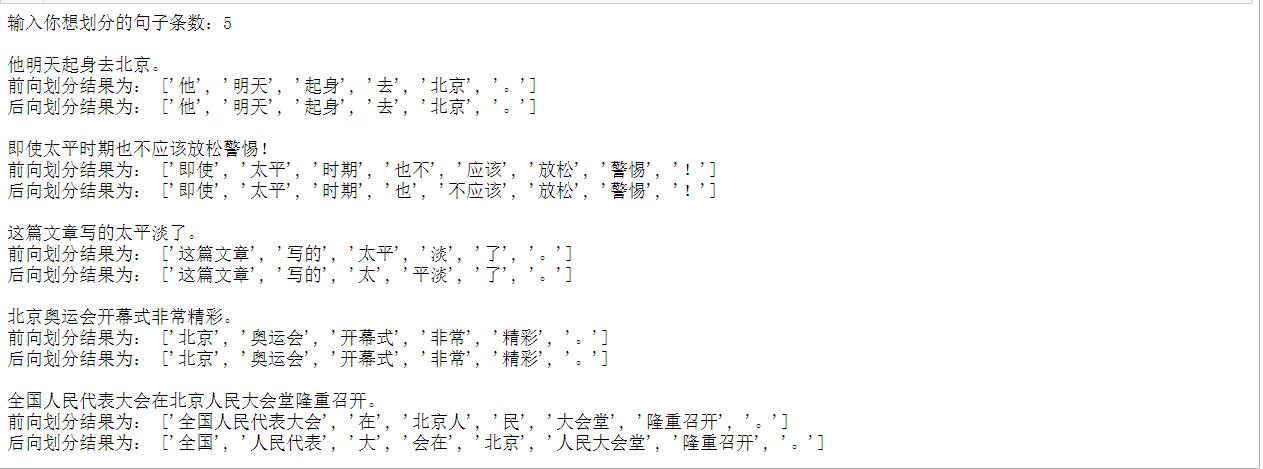作业二:使用前向/后向算法实现中文分词器|自然语言
Posted 桃陉
tags:
篇首语:本文由小常识网(cha138.com)小编为大家整理,主要介绍了作业二:使用前向/后向算法实现中文分词器|自然语言相关的知识,希望对你有一定的参考价值。
具体的前向、后向算法可见此链接。
源代码
import re
#前向算法
def MMseg_cut(sentence, dictA):
# sentence:要分词的句子
#dictA:机器词典
result = [] #存放分好的词
sentenceLen = len(sentence) #待分词字段长度
n = 0
maxDictA = max([len(word) for word in dictA]) #取词典中最长词条的字符长度
while sentenceLen>0:
maxCutLen = min(maxDictA,sentenceLen) #如果当前字段长度小于词典最长字段长度时,取当前字段长度进行划分
sub_sen = sentence[0:maxCutLen]
while maxCutLen>0:
if sub_sen in dictA:
result.append(sub_sen)
break
elif len(sub_sen)==1:
#长度为1说明词典中并无此词,则直接放入result中
result.append(sub_sen)
break
else:
#否则,删去最后一个字,重新操作
maxCutLen-=1
sub_sen = sub_sen[0:maxCutLen]
#更新当前未匹配字段及其长度
sentence = sentence[maxCutLen:]
sentenceLen -=maxCutLen
print("前向划分结果为:",result) # 输出分词结果
#后向算法
def RMMseg_cut(sentence,dictB):
# sentence:要分词的句子
#dictA:机器词典
result = []
sentenceLen = len(sentence)
maxDictB = max([len(word) for word in dictB])
while sentenceLen>0:
maxCutLen = min(sentenceLen,maxDictB)
sub_sen = sentence[-maxCutLen:]
while maxCutLen>0:
if sub_sen in dictB:
result.append(sub_sen)
break
elif len(sub_sen)==1:
result.append(sub_sen)
break
else:
maxCutLen-=1
sub_sen = sub_sen[-maxCutLen:]
sentence = sentence[0:-maxCutLen]
sentenceLen -= maxCutLen
print("后向划分结果为:",result[::-1],end="")
#得到字典
def get_dict(file_path):
f = open(file_path,"r", encoding='utf-8',errors='ignore')
dictA =
for lines in f.readlines():
lines =re.findall('[\\u4e00-\\u9fa5]+',lines)
for line in lines:
if line not in dictA:
dictA[line] = 1
else:
dictA[line] += 1
return dictA
#主函数
if __name__=='__main__':
#词库地址
dataSet_path = "E://大三上//自然语言//实验//111186763ciku//中文分词词库整理//dict.txt"
#获得词典
dictA = get_dict(dataSet_path)
n = int(input("输入你想划分的句子条数:"))
while(n):
sentence = input()
MMseg_cut(sentence, dictA)
RMMseg_cut(sentence, dictA)
n -= 1
程序运行结果

(1)可以看出当词库非常庞大时,使用前向、后向算法构建的简单中文分词器并不能很好的解决组合型切分歧义问题。
(2)词库可以自己进行选择,只要存入字典中即可。
以上是关于作业二:使用前向/后向算法实现中文分词器|自然语言的主要内容,如果未能解决你的问题,请参考以下文章